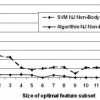Free Online Productivity Tools
i2Speak
i2Symbol
i2OCR
iTex2Img
iWeb2Print
iWeb2Shot
i2Type
iPdf2Split
iPdf2Merge
i2Bopomofo
i2Arabic
i2Style
i2Image
i2PDF
iLatex2Rtf
Sci2ools
CVPR
2007
IEEE
2007
IEEE
Combining Static Classifiers and Class Syntax Models for Logical Entity Recognition in Scanned Historical Documents
Class syntax can be used to 1) model temporal or locational evolvement of class labels of feature observation sequences, 2) correct classification errors of static classifiers if feature observations from different classes overlap in feature space, and 3) eliminate redundant features whose discriminative information is already represented in the class syntax. In this paper, we describe a novel method that combines static classifiers with class syntax models for supervised feature subset selection and classification in unified algorithms. Posterior class probabilities given feature observations are first estimated from the output of static classifiers, and then integrated into a parsing algorithm to find an optimal class label sequence for the given feature observation sequence. Finally, both static classifiers and class syntax models are used to search for an optimal subset of features. An optimal feature subset, associated static classifiers, and class syntax models are all learned f...
Class Syntax Models | Computer Vision | CVPR 2007 | Optimal Class Label | Optimal Feature Subset | Static Classifiers | Supervised Feature Subset |
| Added | 12 Oct 2009 |
| Updated | 28 Oct 2009 |
| Type | Conference |
| Year | 2007 |
| Where | CVPR |
| Authors | Song Mao, Praveer Mansukhani, George R. Thoma |
Comments (0)

